|
|
|
Sort Order |
|
|
|
Items / Page
|
|
|
|
|
|
|
| Srl | Item |
| 1 |
ID:
173897
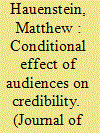

|
|
|
|
|
| Summary/Abstract |
How do leaders signal their intentions during a crisis? Scholars point to audience costs, potential political punishment for bluffing during bargaining, to explain how accountable leaders communicate. However, the empirical support for audience costs is mixed. I argue that this apparent disconnect between theory and evidence is due to different ways that audiences can threaten to use their sanctioning power during a crisis. When determining whether to punish a leader for a failed coercive threat, their domestic supporters should balance concerns over consistency and policy outcomes. As such, accountable leaders’ ability to credibly communicate is not automatic, rather it depends on their supporters’ policy preferences. I apply this insight using casualty sensitivity as a conditioning policy preference. I expect, and find, that audiences only help a leader commit to fight when fighting is low-cost, and actually prevent commitment when fighting is high-cost. Using compellent threat data, I find that audiences have countervailing effects on credibility due to their preferences for leaders who are both consistent and avoid costly conflict. This conditional effect could explain prior mixed support for audience costs in observational data, as prior studies pool together instances where I find audiences have strong, but opposing, effects.
|
|
|
|
|
|
|
|
|
|
|
|
|
|
|
|
| 2 |
ID:
173901
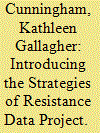

|
|
|
|
|
| Summary/Abstract |
This article introduces the Strategies of Resistance Data Project (SRDP), a global dataset on organizational behavior in self-determination disputes. This dataset is actor-focused and spans periods of relative peace and violence in self-determination conflicts. By linking tactics to specific actors in broader campaigns for political change, we can better understand how these struggles unfold over time, and the conditions under which organizations use conventional politics, violent tactics, nonviolent tactics, or some combination of these. SRDP comprises 1,124 organizations participating in movements for greater national self-determination around the world, from 1960 to 2005. Despite the fact that few self-determination movements engage in mass nonviolent campaigns, SRDP shows that more organizations employ nonviolent tactics at some point in time (about 40%) than employ violence (about 30%). Many organizations switch among tactics or use both at the same time. This dataset will allow analysts to examine the use of different combinations of tactics and patterns of change. We compare the data with the most-used dataset on nonviolence, the NAVCO 2.0 Data Project, to demonstrate what we gain by employing an organization-level dataset on tactics. We present a set of descriptive analyses highlighting the utility of the SRDP, including an examination of tactic switching. We show that more organizations change from violence to nonviolence than the reverse – challenging the widely held assumption that organizations ‘resort’ to violence. SRDP allows scholars to examine organizational choices about tactics, and trends in these tactics, with much greater nuance.
|
|
|
|
|
|
|
|
|
|
|
|
|
|
|
|
| 3 |
ID:
173898


|
|
|
|
|
| Summary/Abstract |
The phenomenon of outbidding, in which terrorist groups escalate their attacks in response to competition from other groups, has long been studied in a domestic terrorism context. If groups exist in the same state, they may compete with one another for the same resources from civilians of that state. This article argues this outbidding logic also exists in a transnational context. Leveraging a sample of Salafi-jihadist groups that are in competition for resources based on shared ideology, this article explores the full effects of this competition on the quantity and severity of groups’ attacks. Building on this outbidding logic as a theoretical lens, Salafi-jihadist groups adjust their attack profiles in response to competition from other groups following this same ideology. This effect is particularly evident among groups that pledge allegiance to al-Qaeda or ISIS. Once pledged, affiliates must now compete with other affiliates for the additional potential resources and recruits who follow the ‘brand’ of al-Qaeda or ISIS. Consistent with this theory, after examining the attacks of all Salafi-jihadist groups from 2001 to 2014, this article finds increased competition among groups results in more attacks and a selection of more severe targets and types of attacks. Affiliate groups respond to competition to the greatest degree.
|
|
|
|
|
|
|
|
|
|
|
|
|
|
|
|
| 4 |
ID:
173895
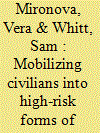

|
|
|
|
|
| Summary/Abstract |
We consider whether prior political activism increases the likelihood of engaging in higher-risk forms of violent collective action. We test our hypothesis in the context of the 2014 Euromaidan and subsequent separatist violence in Eastern Ukraine. In the aftermath of the Euromaidan protests, the Ukrainian government began a widespread campaign to mobilize young men for military service against separatist movements in the Donbas region amid escalating tensions with Russia. In July 2014, we survey young men who were volunteering to join the Ukrainian military’s counterinsurgency efforts and compare them to other young men who live in the same community but had not volunteered. Using a case control study design, we interviewed 100 young men who reported to a local Ukrainian army recruitment station in Kharkiv, a city in Eastern Ukraine which was an important center for military recruitment efforts. We compared them to 100 other young men who lived in the same communities, received recruitment notices, but had chosen not to report. Military recruits were sampled by cluster-sampling at the recruitment station, with random selection of recruits by cluster. Civilian males were sampled by random route in the vicinity of the recruitment station. When comparing survey responses between recruits and civilians, we find strong linkages between prior Euromaidan participation and military mobilization. Our results are robust to controls for parochial ethnocentrism and mere support for Euromaidan goals. Maidan participation and military mobilization are also correlated with a strong sense of self-efficacy, optimism, risk tolerance, patriotic nationalism, and feelings of in-group solidarity with protesters and the military. These correlates illustrate plausible mechanisms for how individuals could transition to increasingly higher-cost, higher-risk forms of collective action.
|
|
|
|
|
|
|
|
|
|
|
|
|
|
|
|
| 5 |
ID:
173900
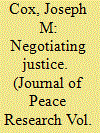

|
|
|
|
|
| Summary/Abstract |
Post-conflict justice is an integral component in maintaining stability and building peace in the aftermath of civil conflict. Despite its instrumental function, scholars routinely find that policymakers’ choice of justice is shaped by the structural conditions of the post-conflict environment, with outright victories leading to retributive forms of justice and negotiated outcomes yielding restorative forms of justice. However, existing literature conflates ceasefires and peace agreements into a single phenomenon, thereby overlooking the independent effects of each outcome. Leveraging the dual sovereignty framework, this article argues the conflation of negotiated outcomes is problematic because peace agreements and ceasefires generate different post-conflict environments. Relative to ceasefires, peace agreements lead to a reduction in the degree of dual sovereignty because they resolve a conflict’s incompatibility, thereby encouraging efforts to move society beyond war through restorative forms of justice. Due to the persistent threat of recurrent war generated by high levels of dual sovereignty, policymakers following ceasefires will be inclined to pursue retributive forms of justice that may target political opponents or potential defectors to bolster organizational strength. Statistical analyses confirm the underlying expectation that ceasefires and peace agreements yield different post-conflict justice outcomes. Peace agreements, relative to ceasefires, are more likely to be followed by the implementation of amnesties and reparations, whereas ceasefires exhibit a greater probability of yielding purges in the post-conflict environment.
|
|
|
|
|
|
|
|
|
|
|
|
|
|
|
|
| 6 |
ID:
173894


|
|
|
|
|
| Summary/Abstract |
Global climate change makes extreme precipitation events likely to become more frequent and intense in large parts of Africa. We study the effect of rainfall shocks on intimate partner violence in sub-Saharan Africa. The analysis shows the presence of spatial autocorrelation in rainfall shocks, which compromises the exogeneity of rainfall shocks in many applications. We correct for the autocorrelation using spatial polynomials. In particular, we use three different estimation strategies. We first use the complete cross-sectional sample to analyze whether recent droughts are correlated with respondents’ experience with intimate partner violence during the last year. We then use the nine countries with repeated surveys to construct a repeated cross-section analysis at the grid level. Finally, we use event history analysis on a time series constructed from the information provided by the abused women about when the violence first took place. We find no robust evidence that droughts increase intimate partner violence. Potential explanations are that the rainfall shocks do not affect spouses’ power, or that the slow onset of the droughts allows for a calmer response to the crisis. We contribute to the wider literature on climate and conflict as many of the mechanisms, economic and psychological, that link climate to violence apply to both intimate partner violence and organized violence.
|
|
|
|
|
|
|
|
|
|
|
|
|
|
|
|
| 7 |
ID:
173896
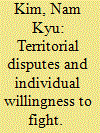

|
|
|
|
|
| Summary/Abstract |
Extant scholarship establishes that territorial issues are more likely than other types of issues to lead to militarized interstate disputes and war. One key premise is that a strong attachment to the material and symbolic values of the homeland makes people more willing to fight for their country in territorial disputes. However, there is no systematic evidence for this premise. Although recent studies investigate the effect of territorial conflict on individual attitudes and find that territorial issues are qualitatively different from other types of issues, researchers have not yet investigated how territorial threats influence people’s willingness to fight. By combining data on territorial claims from the Issue Correlates of War project with individual-level data from the World Values Survey, this article tests the relationship between territorial claims and individuals’ willingness to fight. My analysis reveals that respondents are more willing to fight for their country when their countries experience territorial claims. Building on the contentious issues approach, I further demonstrate the importance of issue salience and issue context in the relationship between territorial claims and willingness to fight. Last, I show that the relationship between territorial claims and willingness to fight depends on a country’s level of economic development or regime type.
|
|
|
|
|
|
|
|
|
|
|
|
|
|
|
|
| 8 |
ID:
173899
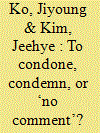

|
|
|
|
|
| Summary/Abstract |
What explains a patron’s decision to publicly condone, condemn, or forgo commenting on its client’s unilateral provocations? We present a new theoretical framework that identifies a patron’s two strategic considerations – maximizing its sphere of influence and avoiding entanglement – and factors that affect them. We claim that whenever a patron faces a great power rivalry or a vulnerable client, it is more likely to condone its client’s provocations in order to safeguard its sphere of influence. On the other hand, when the risk of escalation looms large, the patron is more likely to condemn its client’s provocations in order to avoid entanglement. Focusing on the Sino-North Korean patron–client relationship, we test our theory on an original dataset that tracks China’s official reactions to provocations initiated by North Korea. We find that China tends to condone North Korea’s provocations when the USA criticizes them, and refrains from condemning when North Korea is domestically fragile. We also find that China is more likely to condemn its client’s provocations in the period after North Korea became a nuclear state. In addition, we draw on examples from the USA–Pakistan and the USA–Israel patron–client relationships to illustrate our causal logic. This article offers new insights on how a patron manages its client’s unruly behavior, and provides the first large-N evidence on China’s responses to North Korean provocations from 1981 to 2016.
|
|
|
|
|
|
|
|
|
|
|
|
|
|
|
|
| 9 |
ID:
173902


|
|
|
|
|
| Summary/Abstract |
This article summarizes the Correlates of War Intergovernmental Organizations (IGO) Version 3.0 datasets. The new datasets include information about the population of IGOs in the international system and state participation in those formal international institutions from 1816 to 2014. Consistent with Versions 2.0 and 2.3, Version 3.0 of the IGO data comes in three forms: country-year, IGO-year, and joint dyadic membership. This article briefly describes the data collection process and identifies important changes to the dataset before moving to analyze fundamental patterns in the data. Most notable among the changes from earlier versions of the data is the inclusion of annual membership data for the 1815–1964 time period. In addition, we present information about the overall trends in the institutionalization of cooperation at both the global and regional levels, with the latter focusing on the interesting membership dynamics in Asia and Africa. We then track and discuss patterns in state memberships and examine how these changes manifest in the dyadic data. The article concludes with a discussion of how the COW IGO 3.0 data compare to other prominent datasets on state participation in international institutions and highlights some new areas of research that will benefit from the release of the updated IGO membership dataset.
|
|
|
|
|
|
|
|
|
|
|
|
|
|
|
|
|
|
|
|
|